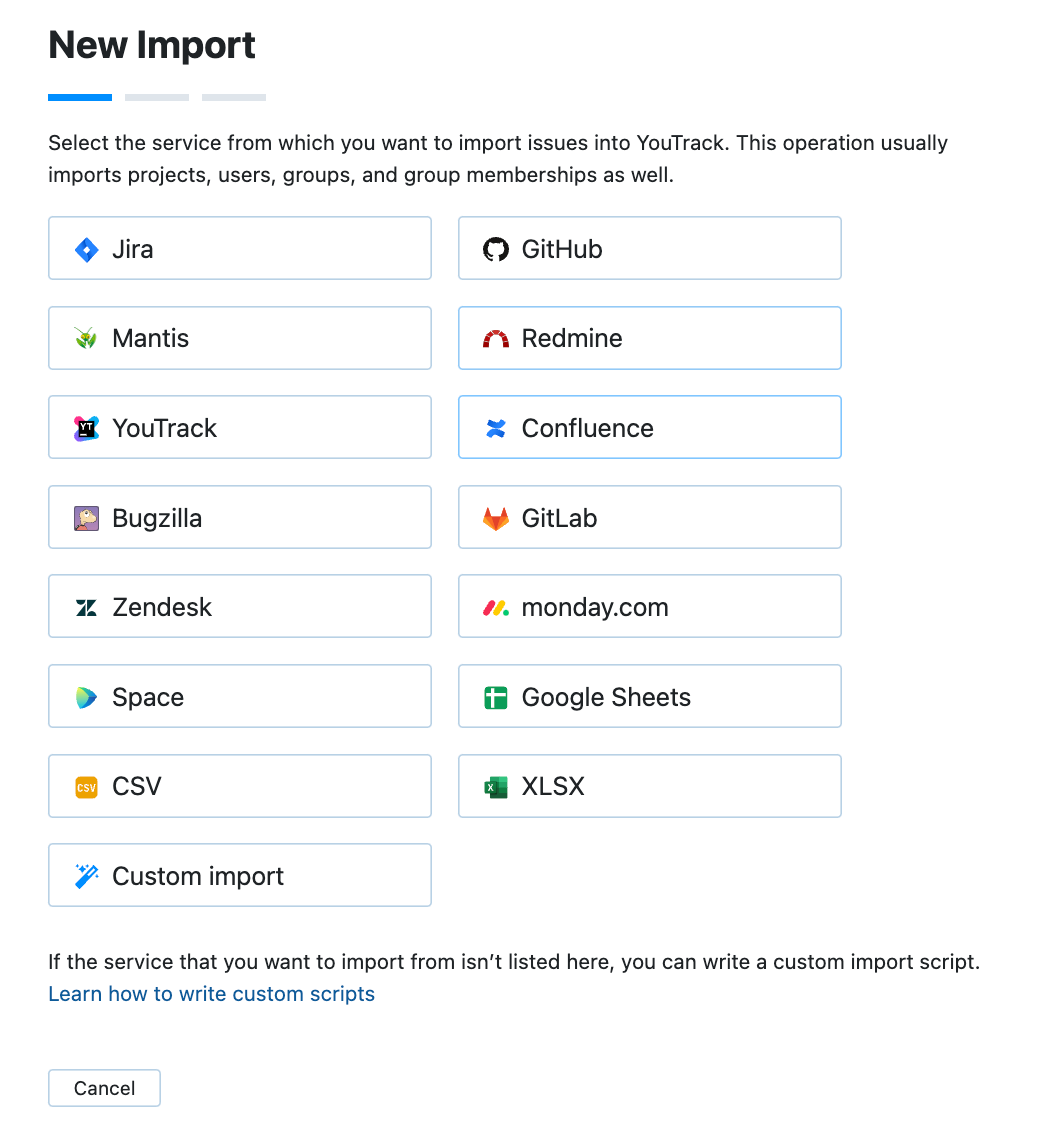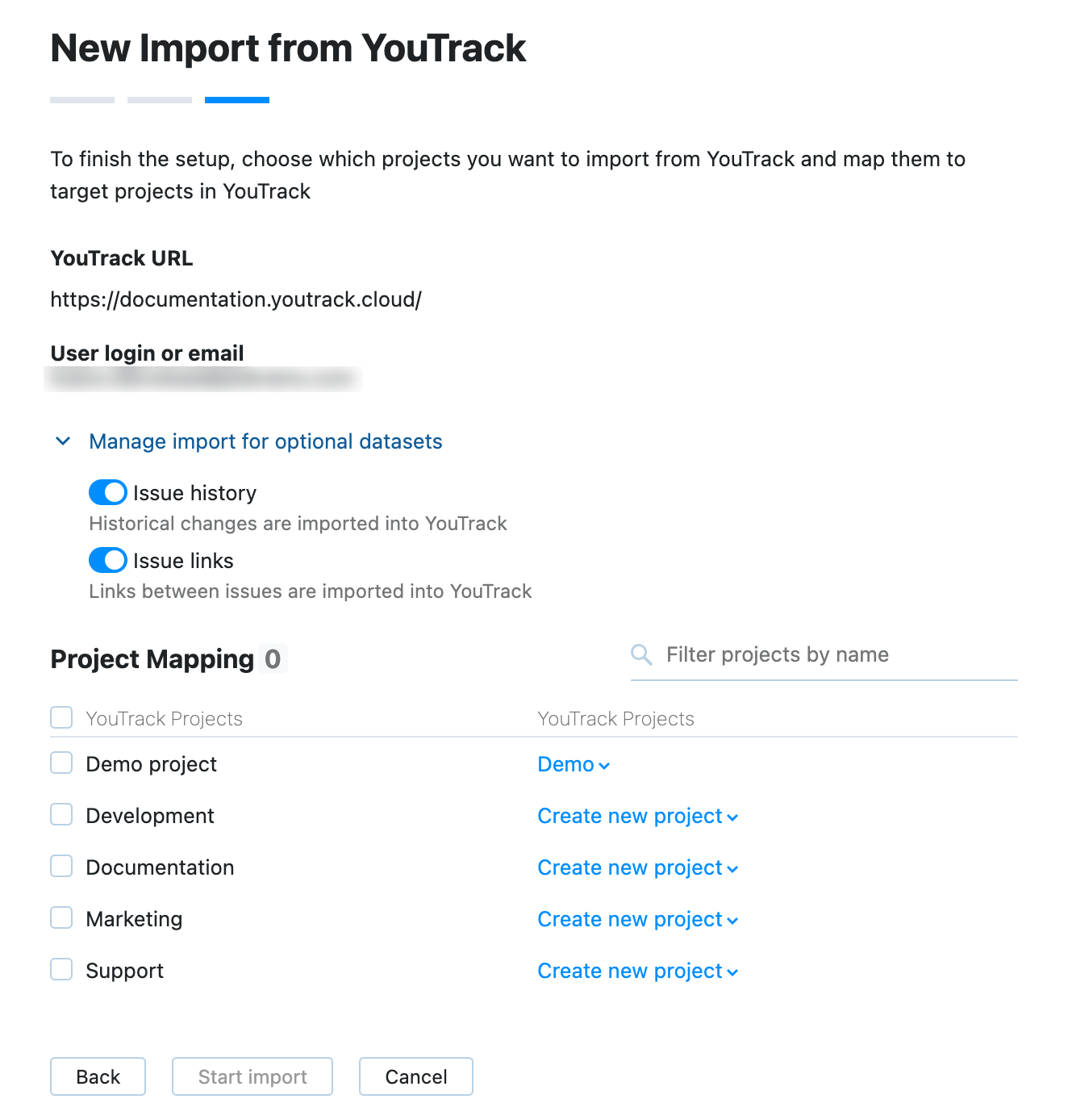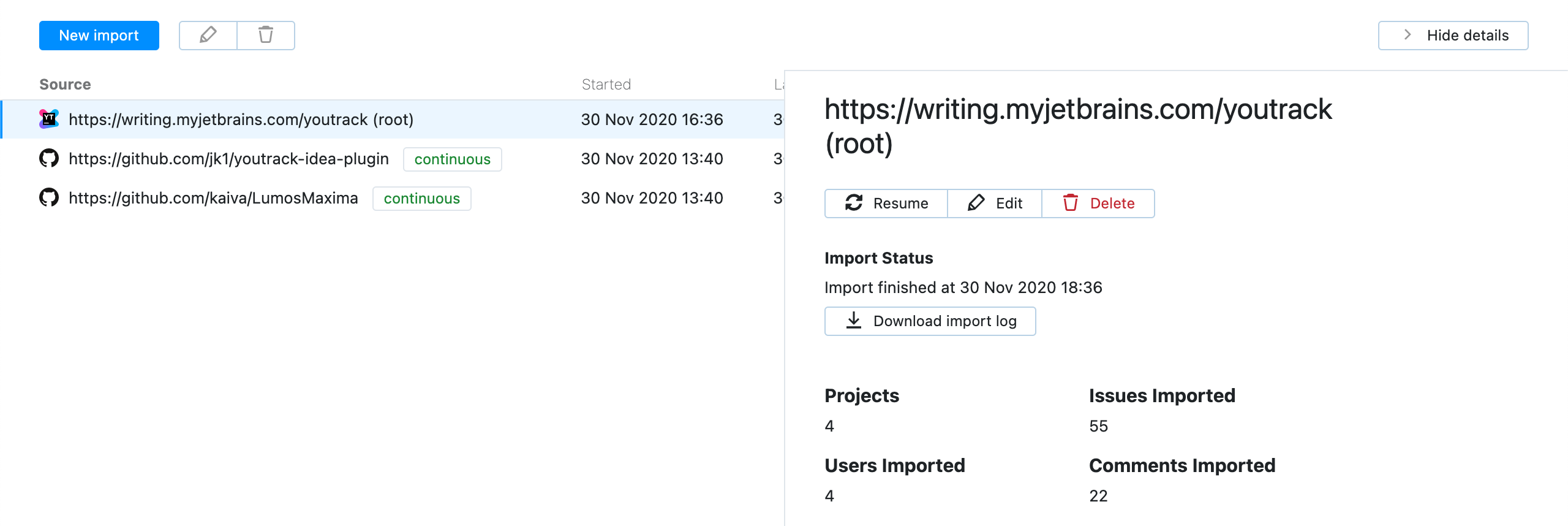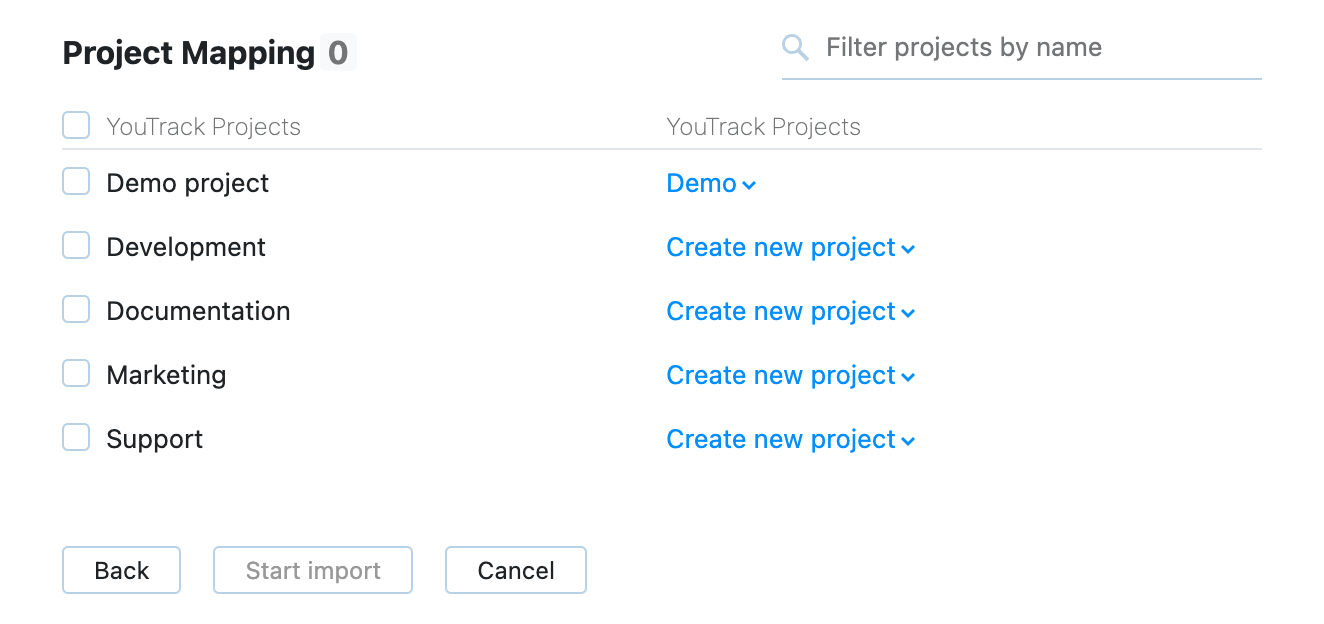Import from YouTrack
The import from YouTrack lets you migrate projects, issues, users, group, and other data from another YouTrack service.
A setup wizard navigates you through the import configuration process. It prompts you to enter the connection settings and lets you map projects in the target YouTrack to projects in the source YouTrack. If your source YouTrack has a custom set of fields for issues, you can edit the import script in the target YouTrack directly.
Prerequisites
Before you import projects from another YouTrack, check the following requirements:
Your source YouTrack version is 2017.1 or later.
Your YouTrack services are accessible to inbound connections. Specifically, you need to make sure that your network doesn't block connections between your source YouTrack and the target one.
Your user account in the source YouTrack service has administrative permissions.
You have direct access to log in to the source application using a password or token.
YouTrack's import engine doesn't support authentication through external authentication modules.
Import Details
If the source YouTrack database contains references to entities that do not exist in the target YouTrack yet, they are created. The target YouTrack user account you use to run the import should have enough permissions to create all imported entities. We recommend using an account with a System Admin role or the Low-level Admin Write permission to run the import.
Imported Entities
The import script migrates data from the source YouTrack including projects, issues, comments, attachments, issue tags, issue links, work items, issue history, custom fields, users, and groups.
Import Limitations
Here is the list of entities that are not imported from the source YouTrack to the target:
Reports
Dashboards
Agile boards
Work item types
Set up an Import from Another YouTrack Installation
Before you add a new import configuration, you need to create a personal access token that will grant access to the target project in the YouTrack source installation. Then you can use the token for authorization when setting up the import configuration in the target YouTrack.
Create a Permanent Token in YouTrack
To set up an import of issues from another YouTrack, first, you need to create a personal access token in the source YouTrack.
Use the following scopes for the token:
YouTrack
YouTrack Administration
To generate a new permanent token:
Click your avatar in the application header and select Profile from the menu.
Switch to the Account Security tab.
Click the New token button.
In the New Permanent Token dialog, specify a name for the new token and the access scope for it. The scope for the token is a list of services which you can access with this new token.

YouTrack installations that use a built-in Hub service have separate scopes for YouTrack and YouTrack Administration.
The YouTrack scope grants permission to work with issues, tags, commands, agile boards, dashboards, reports, and other basic operations in YouTrack.
The YouTrack Administration scope grants permission to work with projects, manage user access, and update server settings.
These scopes also give you the ability to send REST API calls to the following endpoints:
Scope
URLs
Description
YouTrack
/rest/.../api/...Send API requests to the end-user part of YouTrack: issues, tags, commands, agile board, dashboard and reports.
YouTrack Administration
/hub/api/.../hub/rest/...Send API requests to the administration part of YouTrack: project and access management, server settings, etc.
Click the Create token button.
A dialog window with the new token is displayed.

Use either of these two actions to copy the token:
Click the Copy token button.
Select the token with your pointer and use the standard keyboard shortcut for your operating system to copy the current selection to the clipboard.
After you copy the token, close the dialog.
The new token is associated with your user account and is displayed in the Permanent Tokens list.

Configure an Import from YouTrack
The setup wizard guides you through the setup process.
To configure an import from YouTrack:
From the Administration menu, select .
Click New import to open the setup dialog.

Select YouTrack.
Settings for a New Import from YouTrack are displayed.

Enter values for the following settings:
Setting
Description
YouTrack URL
The Base URL of the source YouTrack service.
For a YouTrack Cloud instance hosted on the
myjetbrains.comdomain, the URL must include the trailing/youtrackpath.Username or email
A username or email for the user account in the source YouTrack instance with the access to the projects that you need to import.
Token
The permanent token of the user account in the source YouTrack.
If required by your YouTrack installation, enable the Use SSL key for client authentication option.
Click the Next button.
The second set of import settings is displayed.

Expand the Manage import for optional datasets section. Here you can configure the import engine to ignore certain parts of the source database during import.
Setting
Description
Issue history
Disable this toggle to ignore historical changes of issues during import.
Issue links
Disable this toggle to ignore links between issues during import.
By default, these toggles are enabled. This means that YouTrack will pull historical changes and issue links from the import source if the import script supports it.
Select the source and the target YouTrack projects for the import. For more details about project mapping configuration, see Project Mapping.
Click the Start import button.
YouTrack creates new projects and imports data to the existing ones according to the configured project mapping.
YouTrack imports issues, comments, and users from the selected source YouTrack projects to the target YouTrack projects.
When you have set up an import project, it appears in the Imports list. To view configuration and import details, select an import configuration from the list.

In the sidebar, YouTrack shows the import status, the date and time of the last import, and additional information about the imported data. If there are any problems encountered during import, the error messages are displayed here.
Click the Resume button in the toolbar to import updates from the connected YouTrack project.
You can also download the import log file to study and investigate when needed.
Project Mapping
On the final step of the import setup, you have an option to select those projects that you want to import to the target YouTrack. You can also choose whether to create a new project for the import or import data into an existing project in YouTrack.

To configure project mapping:
Locate those projects that you want to import.
Use the filter bar on the right to filter projects by name.
Select the projects that you want to import. Select the option at the top of the list to import all projects available in the source YouTrack.
Select a target project for each source project.
When loading the list of source projects for mapping, YouTrack checks for existing target YouTrack projects with corresponding names. If it finds a project with the same name as the imported one, YouTrack suggests it as the target project.
If there is no existing project in the target YouTrack with the same name, YouTrack suggests creating a new one.
If you want to change a target project, select another option from the corresponding dropdown on the list.
Click Start import to finalize import setup and start import.
Import starts.
Import Options
After the initial import, the following controls are available in the sidebar:

Control | Description |
|---|---|
Resume | Immediately imports any changes made in the selected source YouTrack projects after the previous import. |
Edit | Opens the integration settings page in edit mode. Use this option to connect to a different YouTrack instance, update the login credentials, or update project mapping. |
Delete | Deletes the current import settings. Projects, issues, comments, users, and groups that were imported from the connected YouTrack instance are not affected. If you delete the import settings and connect to the same YouTrack instance, the issues are re-imported into existing projects with new issue IDs. |
Download import log | Downloads the import log. Use this option to view and investigate errors that occurred during import. |